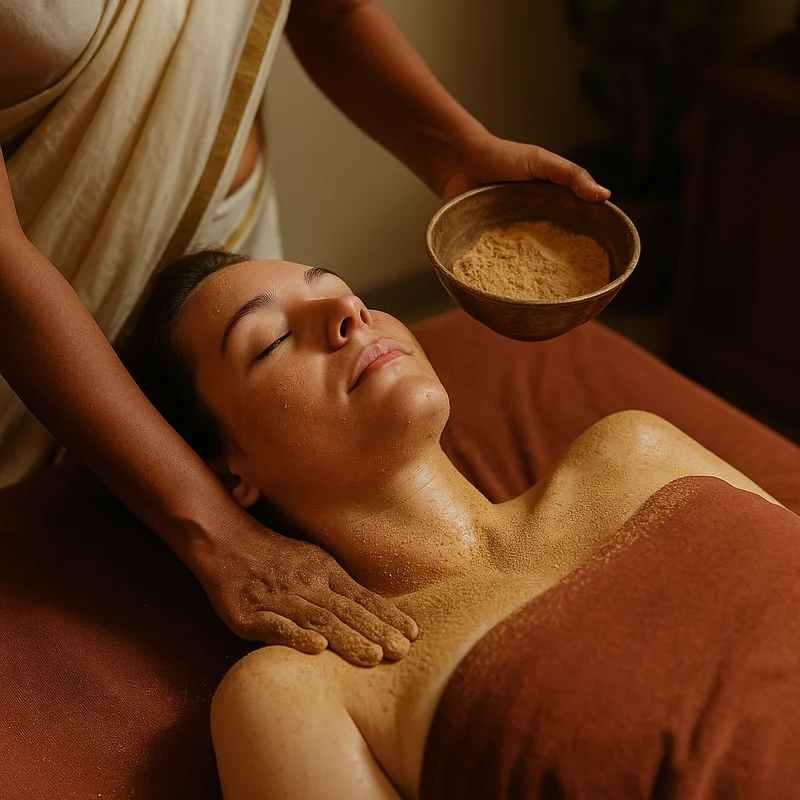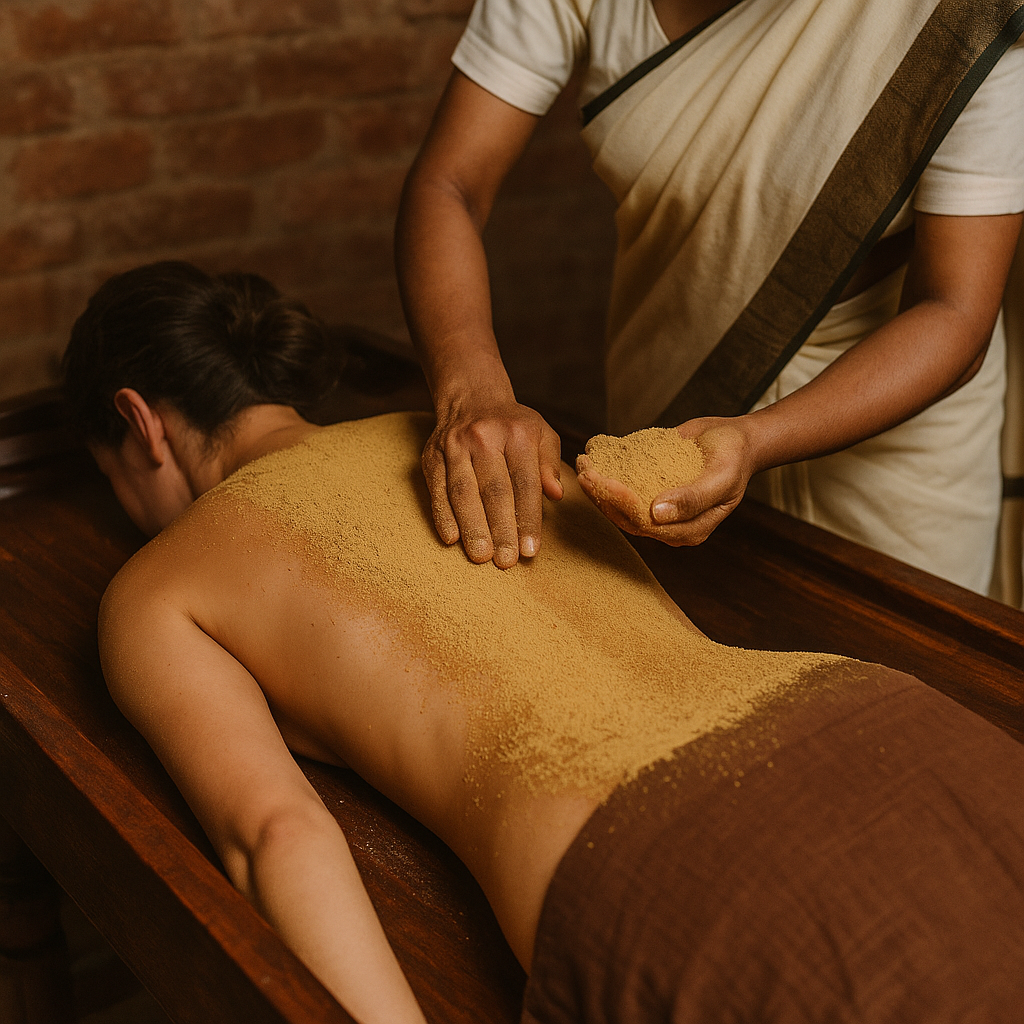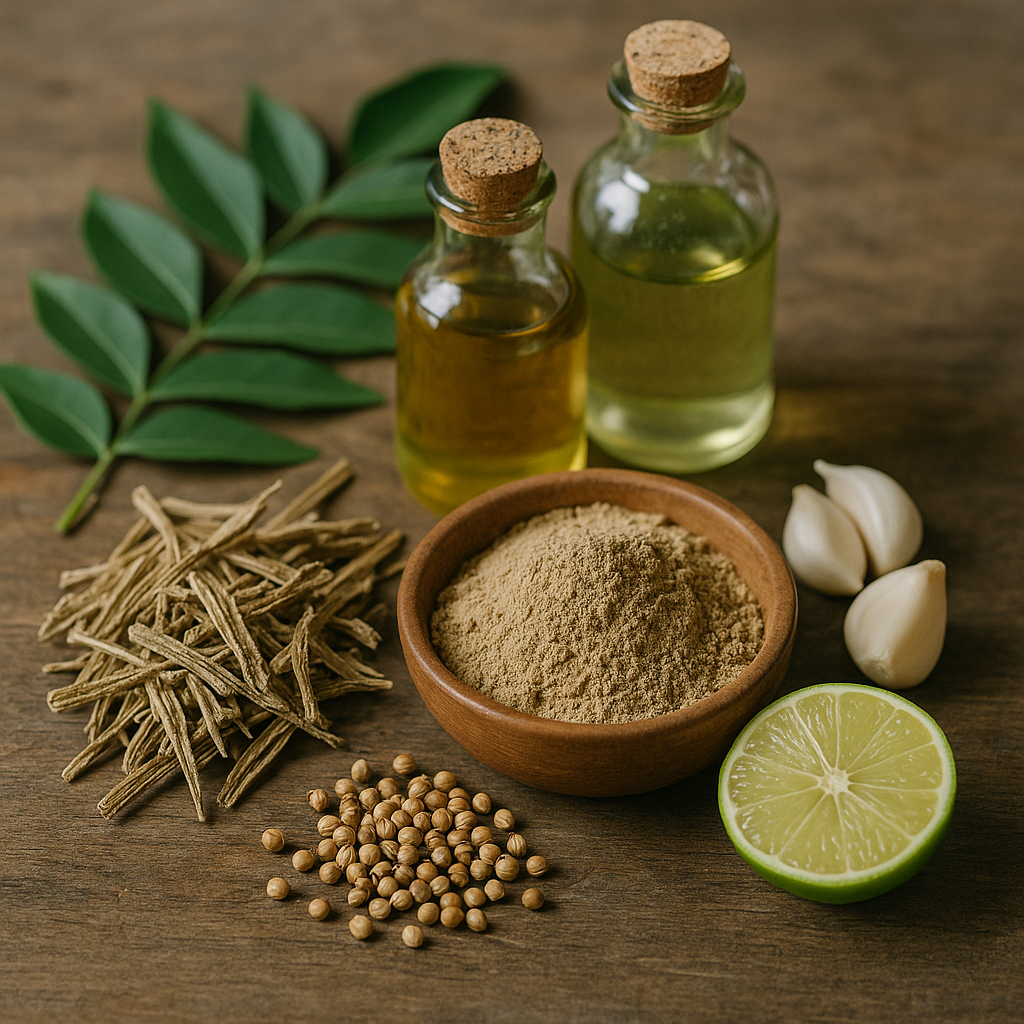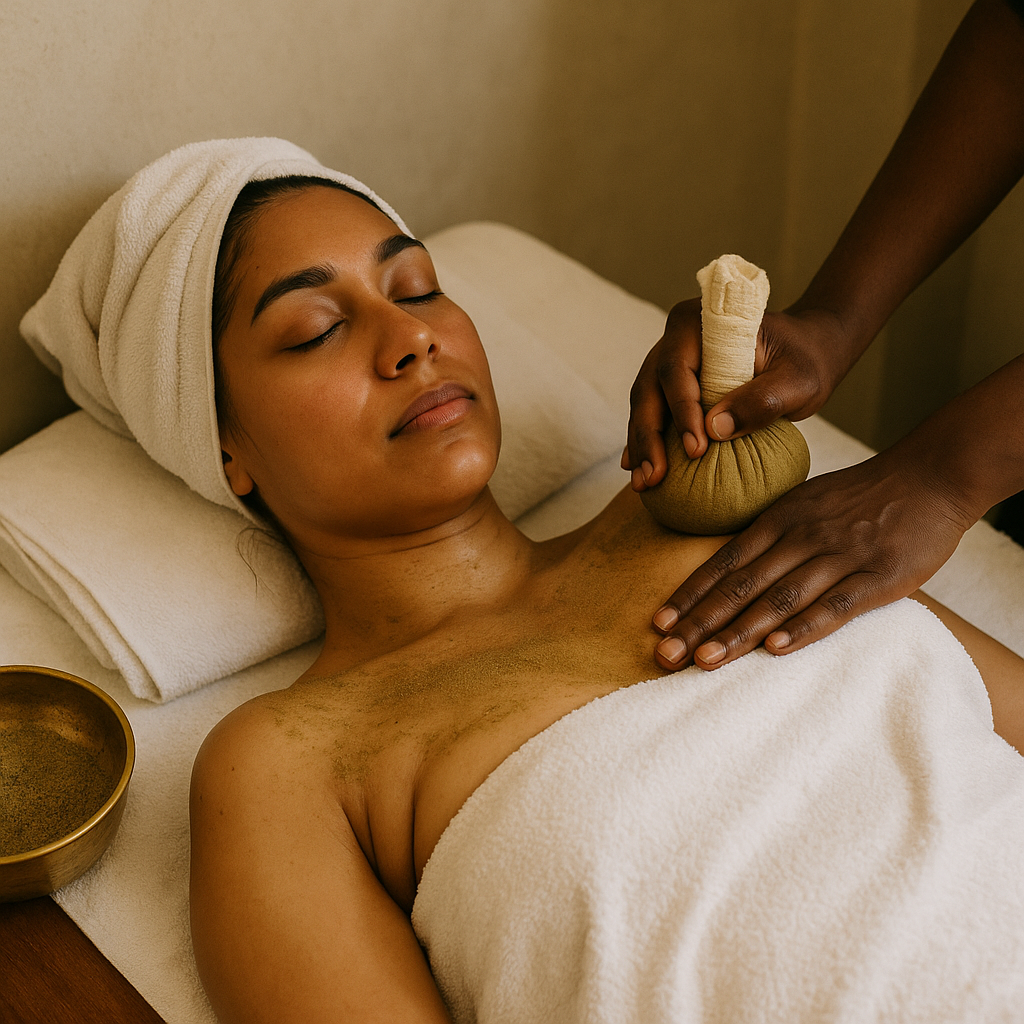Shop Now in Our Store
Powder Massage Ayurveda: A Deep Dive into a Traditional Therapy That Still Surprises

Introduction to Powder Massage Ayurveda
Let’s talk about something you might not expect to fall in love with — getting rubbed down with herbal powders.
Sounds messy, right? Maybe even a little gritty?
But don’t let the image fool you. In the realm of Ayurvedic therapies, powder massage — more traditionally known as Udwarthanam — holds a seriously special place. It's one of those lesser-known treatments that, once you experience it (or even just learn about it properly), makes you wonder why it's not more mainstream.
So, what is powder massage in Ayurveda?
In simple terms, it's a dry or semi-dry massage using herbal powders, typically applied in upward strokes. The idea is to stimulate circulation, cleanse the skin, melt away fat (yes, literally), and balance the body’s energies — known as doshas in Ayurvedic lingo.
But don’t let the simplicity fool you. Powder massage isn’t just rubbing dirt on yourself and hoping for the best. It’s a refined practice with a solid foundation in Ayurvedic philosophy, especially in how it targets Kapha-related imbalances — think sluggishness, heaviness, congestion, excess fat, or lymph stagnation.
And while it may not be as Instagrammable as an oil-dripping Shirodhara or a luxurious Abhyanga massage, it’s got grit. Literally. And sometimes, that’s exactly what your body needs.
Where does this article come in?
This piece? It’s for the curious — for people who’ve maybe heard a whisper of Udwarthanam in their wellness circles, or maybe you stumbled across it while doomscrolling through detox options. It’s also for the practitioners and seekers who want the real deal — grounded insights, historical roots, procedural breakdowns, benefits (and the not-so-glamorous truths), all wrapped in language that doesn’t sound like a sales pitch from a resort spa.
So let’s dive deep — we’ll explore not just what it is, but why it matters, how it’s done, what to expect, and what the science and tradition say about this strangely beautiful ritual of powdered healing.
Ready?

History and Origin of Powder Massage Ayurveda
There’s something comforting about ancient things. Especially when they’ve managed to stay alive through generations of shifting trends and modern medicine. Powder massage — or Udwarthanam, to use the classical term — is one of those timeless things.
Let’s peel back the layers.
Historical Background and Roots of Powder Massage Ayurveda
Udwarthanam comes from two Sanskrit words: ud (meaning upward) and vartanam (meaning to move or rub). It refers to the vigorous, upward strokes used during this type of massage.
Unlike oil massages that soothe and calm, Udwarthanam is more like a wake-up call for the body. Historically, it was recommended for people suffering from conditions that involved “heaviness” — physically and mentally. In ancient India, it wasn’t uncommon for royalty or warriors to undergo this therapy, especially when preparing for battle or shedding excess weight during peace times.
Yes, you read that right. This wasn’t just about beauty — it was about function. Power. Readiness.
Ayurvedic Textual References about Powder Massage Ayurveda
The Charaka Samhita and Ashtanga Hridayam, two foundational Ayurvedic texts, mention Udwarthanam multiple times. It’s prescribed as a Kapha-hara (Kapha-reducing) and meda-hara (fat-reducing) treatment.
It’s also noted for its effect on Srotas — the body’s channels. When these channels get clogged due to poor digestion or inactivity, everything starts to feel… off. Think foggy mind, bloated belly, tired limbs. Udwarthanam is one of the therapies designed to re-open these pathways, not just on a physical level but energetically too.
Traditional Use and Evolution of Powder Massage Ayurveda
Originally, Udwarthanam was more of a corrective or therapeutic approach — not something you’d casually get at a spa. It was part of Panchakarma programs, used alongside purgation, emesis, and other detox measures.
Over time, though, it’s evolved. These days, you’ll see powder massage offered in Ayurvedic clinics, wellness resorts, and even some urban spas — but the intention can vary wildly. Some do it purely for slimming or cellulite reduction. Others keep it rooted in tradition, using the right herbs, dosha analysis, and proper post-care.
And just between us — the difference really matters. You’ll feel it.
Purpose and Benefits of Powder Massage Ayurveda
Okay, here’s where it gets juicy. You know those treatments that promise everything under the sun but somehow don’t deliver much of anything? Yeah… this isn't one of them.
Powder massage does exactly what it says — and maybe even a little more.
Let’s break it down.
Physical Health Benefits of Powder Massage Ayurveda
First off: circulation. That’s the big one. Those brisk, rhythmic strokes? They’re not just for show. They stimulate blood flow, support lymphatic drainage, and help dislodge stubborn fat deposits.
Second: exfoliation. Seriously — you’ve never felt your skin this clean. Dead skin, toxins, even mild skin disorders (like rough patches or early-stage fungal infections) can improve over time.
Third: weight loss support. And yes, I’m going to tread carefully here because this isn’t a magic fix. But when combined with proper diet and detox, powder massage absolutely helps mobilize fat tissue — especially stubborn areas like belly, thighs, and arms.
Mental and Emotional Benefits of Powder Massage Ayurveda
You wouldn’t think scrubbing yourself raw with herbs would feel soothing, but weirdly, it is.
There’s a meditative rhythm to the process — the warm powder, the dry heat, the repetition. People often report feeling mentally lighter, more “awake” after sessions. It’s as if something foggy just lifts off you.
It’s especially good for Kapha-type emotions — lethargy, dullness, emotional stagnation. Powder massage helps shake that off.
How Powder Massage Ayurveda Balances the Doshas (Vata, Pitta, Kapha)
Here’s where Ayurveda geeks (myself included) get excited.
Powder massage is primarily Kapha-pacifying. The dryness, warmth, and friction help counter Kapha’s cool, moist, heavy nature. It’s also Meda-doshahara — meaning it targets fat tissue imbalances.
But here’s the twist — depending on the herbs used, it can also be customized. Want to calm Vata? You can mix in warming, grounding herbs like ashwagandha or sesame powder. Pitta too hot to handle? Cooling herbs like sandalwood or vetiver might get added.
Customization is key. And this is where going to a real practitioner makes a world of difference.
In short: If your body feels stagnant, if your energy is sluggish, or if your skin seems like it’s forgotten how to breathe — powder massage might be the gentle (but gritty) slap it needs to wake up.
Detailed Procedure and Steps of Powder Massage Ayurveda
Let’s get hands-on for a minute. How is this thing actually done?
I’ll walk you through it the way a practitioner might explain it to a first-timer. Because the first time is… well, let’s just say it’s not quite what you expect. It's intense, but in a good way.
Preparation for Powder Massage Procedure
Before the massage even starts, there’s a little ritual to it.
-
Assessment: A practitioner will typically assess your dosha constitution and any imbalances. It’s not a one-size-fits-all thing.
-
Herb selection: Based on your current state (feeling sluggish, overly anxious, etc.), the powder mix is chosen. It can be purely dry or mixed with a little oil or buttermilk depending on the version used (dry vs. Snigdha-Udwarthanam).
-
Environment: Warm room. Dim lighting. No AC blasting in your face — your body needs to stay warm throughout.
Clothes off, modesty cloth on, and you’re good to go.
Step-by-step Guide of Powder Massage Procedure
-
Application begins at the feet, moving upward with brisk, rhythmic strokes — always against the direction of hair growth. (Feels weird at first. Gets addictive.)
-
Herbal powders are rubbed in, sometimes with a linen glove, sometimes bare-handed. The idea is friction and stimulation — not relaxation like in oil massage.
-
Upward motion is key — this stimulates lymphatic drainage and breaks down ama (toxins).
-
Entire body is covered, including limbs, back, chest, and sometimes abdomen.
-
Duration: Around 30–45 minutes, depending on your constitution and energy.
It’s vigorous. You’ll sweat. It can feel a bit like a workout — one that someone else is doing on you.
Duration and Frequency Recommendations for Powder Massage
This isn’t a one-time deal. In therapeutic settings, a course of 7, 14, or 21 days is often prescribed.
But for general detox, a once-weekly session can work wonders — especially during seasonal transitions or after periods of heavy eating or low activity.

Herbs, Oils, and Ingredients Used in Powder Massage Ayurveda
If you’re imagining some random kitchen spice rub — yeah, nope. These are precise formulations with centuries of wisdom behind them.
But that’s not to say they can’t smell amazing.
Key Herbs and Oils Essential for Powder Massage
Here’s a lineup of some Ayurvedic stars often used:
-
Kolakulathadi Churnam – a classic mix containing horse gram, which has a deep, penetrating heat
-
Triphala – detoxifying and balancing across all three doshas
-
Nagarmotha (Cyperus rotundus) – anti-inflammatory and fat-reducing
-
Turmeric – obviously, for its anti-inflammatory and skin-brightening effects
-
Vacha (Acorus calamus) – sharpens the senses and improves circulation
Sometimes, oils are used to moisten the powders — sesame oil is a go-to, but others like mustard oil or buttermilk are used based on your dosha.
Benefits and Roles of Specific Ingredients
Each ingredient isn’t just chosen because “it smells good” or “seems healthy.”
-
Horse gram increases heat and helps melt subcutaneous fat.
-
Triphala detoxifies at the cellular level.
-
Vetiver cools, grounds the nervous system — great for Pitta.
-
Mustard powder stimulates metabolism and clears sluggish Kapha zones.
They all work together. It’s chemistry, sure — but it’s also energy.
Where and How to Source Quality Ingredients
Ah, this part is tricky. Not all powders are created equal.
If you’re DIYing this at home, please avoid supermarket spice powders. They’re often irradiated, stale, or full of fillers.
Look for:
-
GMP-certified Ayurvedic suppliers
-
Organic and wildcrafted sources when possible
-
Trusted brands like Kottakkal, Arya Vaidya Sala, or even local Ayurvedic pharmacies (if you're in India or Sri Lanka)
If in doubt? Ask a practitioner. Or don’t DIY it — just go experience it first.
Indications and Contraindications for Powder Massage Ayurveda
Here’s where we need to be honest. Powder massage isn’t for everyone. And it's not some panacea you can apply blindly.
Health Conditions and Symptoms Indicating Powder Massage
This therapy shines in the following cases:
-
Obesity or slow metabolism
-
Lethargy, depression, or mental dullness (especially Kapha-based)
-
Skin conditions like acne, keratosis, or fungal issues
-
Poor circulation, varicose vein prevention
-
Postpartum recovery (under Ayurvedic supervision)
Also? It’s amazing for seasonal detox. Especially early spring — when Kapha’s at its peak.
Potential Risks and Contraindications of Powder Massage
Listen — if you’re very Vata-dominant, super dry, or prone to anxiety, this can be too stimulating. The friction, dryness, and intensity might unbalance you more.
Also, avoid it if:
-
You’re pregnant or recovering from a major illness
-
You have active skin rashes or wounds
-
You're in a depleted, weakened state (low ojas)
It’s not dangerous, per se. But it needs to be applied wisely.
Who Should Avoid Powder Massage or Seek Expert Advice
In general, if you’re:
-
Elderly
-
Severely underweight
-
Anxious or suffer from panic disorders
-
Hyper-sensitive skin
Then you really want to check in with an Ayurvedic expert first. Not to scare you — but Ayurveda is personalized medicine. That’s what makes it work.

Aftercare and Post-procedure Recommendations for Powder Massage Ayurveda
So, you’ve just finished a powder massage. Your skin feels like it’s glowing from the inside out, your body is buzzing, and there’s that weird combination of exhaustion and energy.
Now what?
Well — this part is important. Maybe more important than the massage itself.
Recommended Lifestyle Adjustments After Powder Massage
Right after the session, your body is in a state of release. It’s shedding — physically, emotionally, energetically. So don’t go hopping into a freezing cold shower or stuffing yourself with a heavy meal.
Instead:
-
Rest: Let your body settle. Even if you feel supercharged, don’t do anything intense.
-
Keep warm: Your channels (srotas) are open. Avoid drafts, cold water, or exposure to wind.
-
Avoid stimulation: No screen binging or loud music. Give your nervous system a break.
-
Light activity only: Maybe a slow walk. Gentle stretches. Nothing extreme.
And drink warm water. Please. Lots of it.
Diet and Nutrition Guidelines Following Powder Massage
This is key.
Your digestion is going to reboot — that’s part of the whole detox effect. But for it to work well, you’ve got to help it along.
So:
-
Avoid cold or raw foods for 24–48 hours.
-
Stick to warm, soupy, light meals — think kichari, veggie stews, herbal teas.
-
No dairy, sugar, or fried stuff immediately after. These clog things right back up.
-
Ginger tea or cumin-coriander-fennel tea works wonders post-massage.
It’s like this: You’ve cleared the driveway — now don’t throw rocks all over it again.
Common Mistakes and Precautions Post Powder Massage
Here are the mistakes I’ve seen — or, um, done myself:
-
Taking a cold shower immediately. Nope. Lukewarm or warm only.
-
Rushing off to a party afterward. Nope. Your body’s in processing mode, not social mode.
-
Doing just one session and expecting miracles. Sorry. Udwarthanam is cumulative.
-
Skipping the practitioner’s advice on diet or herbs. Every detail matters.
Treat it like sacred space — because, well, that’s what it is.
Scientific Studies and Modern Research on Powder Massage Ayurveda
Let’s zoom out a bit. Ayurveda has ancient roots — but how does it stand up in the lab?
Turns out, pretty well.
Even though research on powder massage specifically is still developing, there’s promising stuff out there.
Research Validating the Benefits of Powder Massage
Several small-scale studies conducted in India and Sri Lanka have shown that Udwarthanam may lead to:
-
Reduction in body mass index (BMI) after multiple sessions
-
Improved lymphatic flow (measured via ultrasound)
-
Skin elasticity improvement in participants with early signs of aging
-
Enhanced metabolism markers, such as improved blood sugar profiles
What’s especially interesting is how these benefits don’t just come from the herbs — it’s the technique that matters. The motion. The friction. The sequence.
Clinical Trials and Evidence Supporting Powder Massage
In 2016, an Ayurvedic medical college in Kerala conducted a 30-day controlled trial on obese patients undergoing Udwarthanam along with dietary changes. The results?
-
Average 3.5 kg weight loss in one month (with no intense workouts)
-
Significant drop in triglyceride levels
-
Patients reported better digestion, mood stability, and reduced food cravings
Other trials have explored combining powder massage with Panchakarma regimens, showing improved outcomes in managing metabolic syndrome and pre-diabetes.
We need more of these studies — larger, more diverse, longer-term. But what’s already out there is compelling.
Comparison Between Ayurvedic and Conventional Methods
Let’s be real — modern weight-loss approaches often rely on pills, diets, and gym obsessions. But they rarely consider energetic balance or emotional detox.
Udwarthanam? It doesn’t just target fat. It targets Kapha imbalance, stagnation, toxicity, lethargy — the roots of weight gain in the Ayurvedic view.
So while a treadmill might burn calories, it won’t clear blocked srotas. Powder massage might not give you abs in a week, but it brings a kind of alignment that lasts.
Real-Life Testimonials and Experiences with Powder Massage Ayurveda
Let’s get out of the theory for a second. Here’s what actual people say — and yeah, these are real stories (names changed for privacy).
Patient Stories and Experiences with Powder Massage
Rita, 43, Delhi:
“I went in expecting a fancy spa scrub. What I got was a full-body awakening. The first session felt weird — gritty, dry, too intense. By the third, I was addicted. I stopped craving sugar and dropped 5 kgs in two weeks.”
Jonas, 35, Berlin:
“I tried Udwarthanam during a Panchakarma retreat in Kerala. I’d never even heard of it. But the way it cleared my brain fog? Unreal. Better than any espresso shot I’ve had.”
Results Achieved and Realistic Expectations
Is this magic? No.
But if done consistently — with the right diet, the right therapist, and a little patience — the results can be surprising:
-
Lighter body
-
Clearer skin
-
Improved digestion
-
Real mental sharpness
Most people feel the shift before they even see it.
Conclusion and Final Thoughts on Powder Massage Ayurveda
Let’s circle back.
Powder massage — or Udwarthanam — isn’t shiny. It’s not trendy. It doesn’t look sexy on Instagram.
But it works.
It’s gritty. Earthy. Deeply intelligent in how it interacts with your body’s systems. It’s one of those Ayurvedic therapies that doesn’t coddle — it challenges. It moves. It clears.
And yes, it’s not for everyone. If your body is already depleted, or if you need nourishment instead of stimulation — this isn’t the move.
But if you feel heavy, stuck, foggy, sluggish — it might be exactly what you need.
I’d say this: Try it once. With a real practitioner. Let go of the need for candles and cucumbers. And just feel what happens.
You might be surprised.
Ready to find out if powder massage is right for you?
Book a personalized consultation at Ask-Ayurveda.com and get matched with an expert who actually gets what your body needs.
Don’t just Google. Get real answers.
Frequently Asked Questions (FAQ) About Powder Massage Ayurveda
1. Is powder massage the same as a body scrub?
Not at all. While both exfoliate the skin, powder massage in Ayurveda (Udwarthanam) is a therapeutic procedure targeting dosha imbalances, fat metabolism, and circulation — not just dead skin.
2. Can I do powder massage at home by myself?
Technically yes — but results will vary. The stroke direction, pressure, and herb selection all matter. If you’re new, it’s best to experience it with a trained Ayurvedic therapist first.
3. How often should I do powder massage for weight loss?
For therapeutic results, it's often done daily or every other day for 14–21 days. For maintenance or detox, once a week is ideal. Always combine with proper diet and hydration.
4. Will it irritate my skin or cause breakouts?
It shouldn't — in fact, it often improves skin health. But if your skin is very sensitive or broken, discuss with a practitioner first. Some herbs can be intense.
5. Is it only for people trying to lose weight?
Nope. It’s also great for improving circulation, lymphatic drainage, mental clarity, and skin texture. It's not just about fat — it's about flow.
6. What’s the difference between dry and oily powder massage?
Dry Udwarthanam uses powders only — better for Kapha and weight loss. Snigdha-Udwarthanam uses powder mixed with oil or ghee — gentler, good for Vata types or during colder months.
This article is checked by the current qualified Dr Sujal Patil and can be considered a reliable source of information for users of the site.
Got any more questions?
Ask Ayurvedic doctor a question and get a consultation online on the problem of your concern in a free or paid mode.
More than 2,000 experienced doctors work and wait for your questions on our site and help users to solve their health problems every day.

